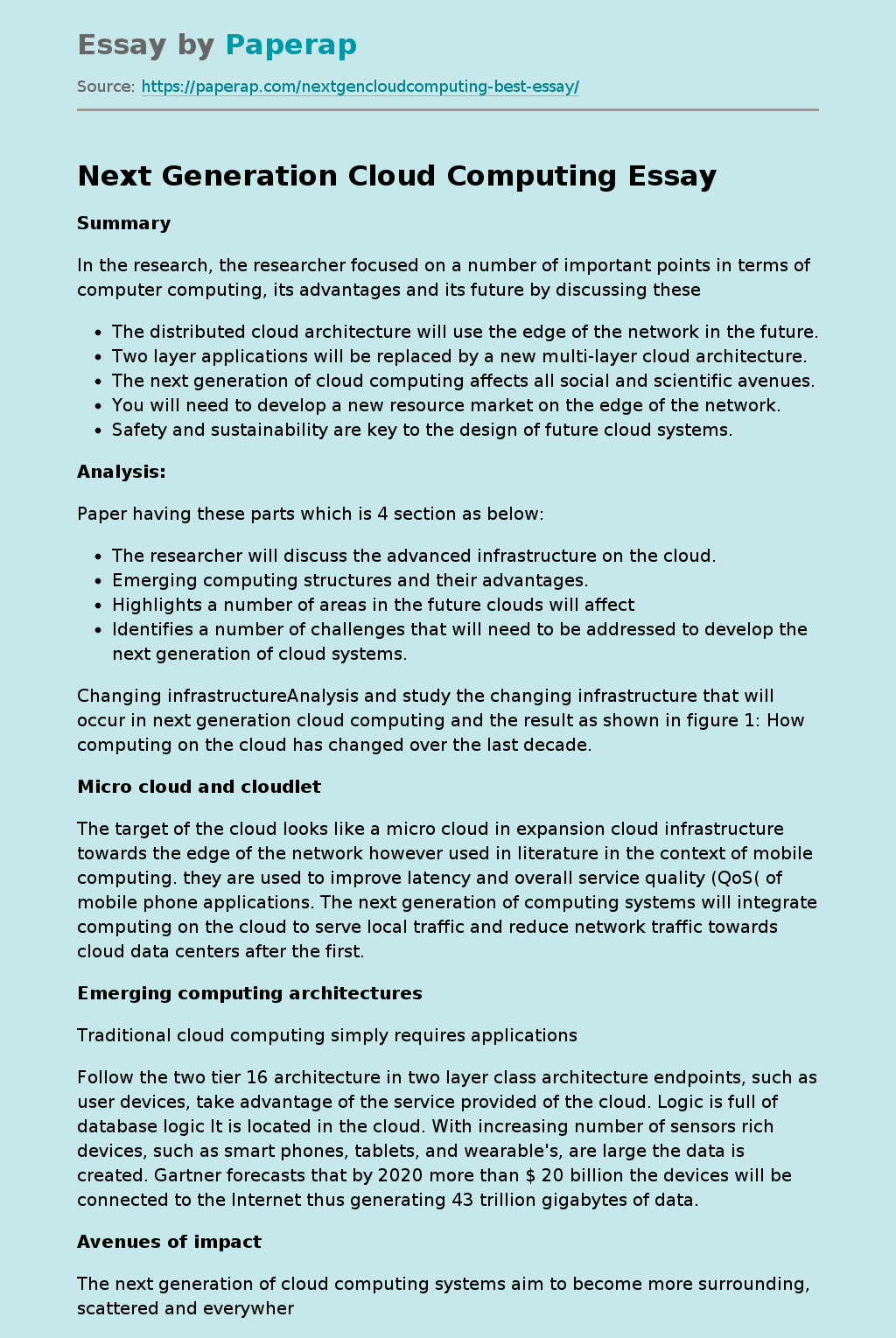Next Generation Cloud Computing
Summary
In the research, the researcher focused on a number of important points in terms of computer computing, its advantages and its future by discussing these
- The distributed cloud architecture will use the edge of the network in the future.
- Two layer applications will be replaced by a new multi-layer cloud architecture.
- The next generation of cloud computing affects all social and scientific avenues.
- You will need to develop a new resource market on the edge of the network.
- Safety and sustainability are key to the design of future cloud systems.
Analysis:
Paper having these parts which is 4 section as below:
- The researcher will discuss the advanced infrastructure on the cloud.
- Emerging computing structures and their advantages.
- Highlights a number of areas in the future clouds will affect
- Identifies a number of challenges that will need to be addressed to develop the next generation of cloud systems.
Changing infrastructureAnalysis and study the changing infrastructure that will occur in next generation cloud computing and the result as shown in figure 1: How computing on the cloud has changed over the last decade.
Micro cloud and cloudlet
The target of the cloud looks like a micro cloud in expansion cloud infrastructure towards the edge of the network however used in literature in the context of mobile computing. they are used to improve latency and overall service quality (QoS( of mobile phone applications. The next generation of computing systems will integrate computing on the cloud to serve local traffic and reduce network traffic towards cloud data centers after the first.
Emerging computing architectures
Traditional cloud computing simply requires applications
Follow the two tier 16 architecture in two layer class architecture endpoints, such as user devices, take advantage of the service provided of the cloud. Logic is full of database logic It is located in the cloud. With increasing number of sensors rich devices, such as smart phones, tablets, and wearable’s, are large the data is created. Gartner forecasts that by 2020 more than $ 20 billion the devices will be connected to the Internet thus generating 43 trillion gigabytes of data.
Avenues of impact
The next generation of cloud computing systems aim to become more surrounding, scattered and everywhere under the appearance trends in distributed, heterogeneous and ad hoc cloud infrastructure and associated computing structures. This will affect the following four areas are discussed in this paper.different layers of the cloud stack where
Research directions
The current cloud systems are primarily focused on VM consolidation to reduce power consumption for servers. However, cooling systems and networks consume a large proportion of the total consume power. You will need to develop emerging techniques which manages the energy efficiency of servers, networks and refrigeration systems. These techniques can benefit from the interaction between IoTenabled cooling systems and data center managers that dynamically make decisions about resources that are turned on / off in both dimensions of time and space based on workload expectations.
Related Work
- D. Bernstein, E. Ludvigson, K. Sankar, S. Diamond, M. Morrow, Blueprint for the intercloud – protocols and formats for cloud computing interoperability, in: Proceedings of the 4th International Conference on Internet and Web Applications and Services, 2009, pp. 328336.
- K. Zhang, X. Zhou, Y. Chen, X. Wang, Y. Ruan, Sedic: Privacy-aware data intensive computing on hybrid clouds, in: Proceedings of the 18th ACM Conference on Computer and Communications Security, 2011, pp. 515526.
- X. Xu, X. Zhao, A framework for privacy-aware computing on hybrid clouds with mixed-sensitivity Data, in: 17th IEEE International Conference on High Performance Computing and Communications, 7th IEEE International Symposium
- A.N. Toosi, R.O. Sinnott, R. Buyya, Resource provisioning for data-intensive applications with deadline constraints on hybrid clouds using aneka, Future Gener. Comput. Syst. (2017).
- B. Rochwerger, C. Vzquez, D. Breitgand, D. Hadas, M. Villari, P. Massonet, E. Levy, A. Galis, I.M. Llorente, R.S. Montero, Y. Wolfsthal, K. Nagin, L. Larsson, F. Galn, An architecture for federated cloud computing, in: Cloud Computing, John Wiley & Sons, Inc., 2011, pp. 391411.
- R. Buyya, R. Ranjan, R.N. Calheiros, InterCloud: Utility-oriented federation of cloud computing environments for scaling of application services, in: Proceedings of the 10th International Conference on Algorithms and Architectures for Parallel Processing, 2010, pp. 1331.
- B. Varghese, N. Wang, S. Barbhuiya, P. Kilpatrick, D.S. Nikolopoulos, Challenges and opportunities in edge computing, in: IEEE International Conference on Smart Cloud, 2016, pp. 2026
- F.P. Tso, D.R. White, S. Jouet, J. Singer, D.P. Pezaros, The glasgow raspberry Pi cloud: A scale model for cloud computing infrastructures, in: 33rd IEEE International Conference on Distributed Computing Systems Workshops, 2013, pp. 108112.
- Y.S.S.A. Elkhatib, B.F. Porter, H.B. Ribeiro, M.F. Zhani, J. Qadir, E. Rivire, On using micro-clouds to deliver the fog, IEEE Internet Comput. 21 (2) (2016) 815.
- A. Sathiaseelan, A. Lertsinsrubtavee, A. Jagan, P. Baskaran, J. Crowcroft, Cloudrone: Micro clouds in the sky, in: Proceedings of the 2nd Workshop on Micro Aerial Vehicle Networks, Systems, and Applications for Civilian Use, 2016, pp. 4144.
Next Generation Cloud Computing. (2019, Dec 05). Retrieved from https://paperap.com/nextgencloudcomputing-best-essay/

